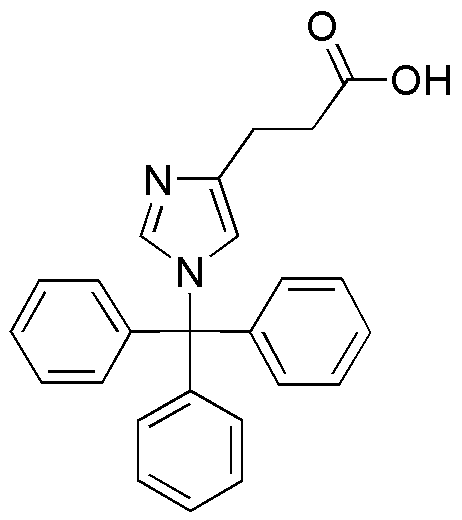N-1-Trityl-deamino-histidine is widely utilized in research focused on:
- Peptide Synthesis: This compound serves as a key building block in the synthesis of peptides, particularly in the development of therapeutic proteins. Its stability and reactivity make it ideal for creating complex structures.
- Drug Development: It plays a significant role in pharmaceutical research, especially in designing new drugs that target specific biological pathways. Researchers appreciate its ability to enhance the bioavailability of active compounds.
- Bioconjugation: The compound is used in bioconjugation processes, allowing for the attachment of drugs or imaging agents to proteins. This application is crucial in targeted therapy and diagnostic imaging.
- Research in Cancer Therapies: Its unique properties make it valuable in developing cancer treatments, where it can help improve the selectivity and efficacy of anticancer agents.
- Protein Engineering: N-1-Trityl-deamino-histidine is utilized in protein engineering to modify protein functions, enhancing their stability and activity for various industrial applications.
General Information
Properties
Safety and Regulations
Applications
N-1-Trityl-deamino-histidine is widely utilized in research focused on:
- Peptide Synthesis: This compound serves as a key building block in the synthesis of peptides, particularly in the development of therapeutic proteins. Its stability and reactivity make it ideal for creating complex structures.
- Drug Development: It plays a significant role in pharmaceutical research, especially in designing new drugs that target specific biological pathways. Researchers appreciate its ability to enhance the bioavailability of active compounds.
- Bioconjugation: The compound is used in bioconjugation processes, allowing for the attachment of drugs or imaging agents to proteins. This application is crucial in targeted therapy and diagnostic imaging.
- Research in Cancer Therapies: Its unique properties make it valuable in developing cancer treatments, where it can help improve the selectivity and efficacy of anticancer agents.
- Protein Engineering: N-1-Trityl-deamino-histidine is utilized in protein engineering to modify protein functions, enhancing their stability and activity for various industrial applications.
Documents
Safety Data Sheets (SDS)
The SDS provides comprehensive safety information on handling, storage, and disposal of the product.
Product Specification (PS)
The PS provides a comprehensive breakdown of the product’s properties, including chemical composition, physical state, purity, and storage requirements. It also details acceptable quality ranges and the product's intended applications.
Certificates of Analysis (COA)
Search for Certificates of Analysis (COA) by entering the products Lot Number. Lot and Batch Numbers can be found on a product’s label following the words ‘Lot’ or ‘Batch’.
Numéro de catalogue
Numéro de lot/série
Certificates Of Origin (COO)
This COO confirms the country where the product was manufactured, and also details the materials and components used in it and whether it is derived from natural, synthetic, or other specific sources. This certificate may be required for customs, trade, and regulatory compliance.
Numéro de catalogue
Numéro de lot/série
Safety Data Sheets (SDS)
The SDS provides comprehensive safety information on handling, storage, and disposal of the product.
DownloadProduct Specification (PS)
The PS provides a comprehensive breakdown of the product’s properties, including chemical composition, physical state, purity, and storage requirements. It also details acceptable quality ranges and the product's intended applications.
DownloadCertificates of Analysis (COA)
Search for Certificates of Analysis (COA) by entering the products Lot Number. Lot and Batch Numbers can be found on a product’s label following the words ‘Lot’ or ‘Batch’.
Numéro de catalogue
Numéro de lot/série
Certificates Of Origin (COO)
This COO confirms the country where the product was manufactured, and also details the materials and components used in it and whether it is derived from natural, synthetic, or other specific sources. This certificate may be required for customs, trade, and regulatory compliance.


